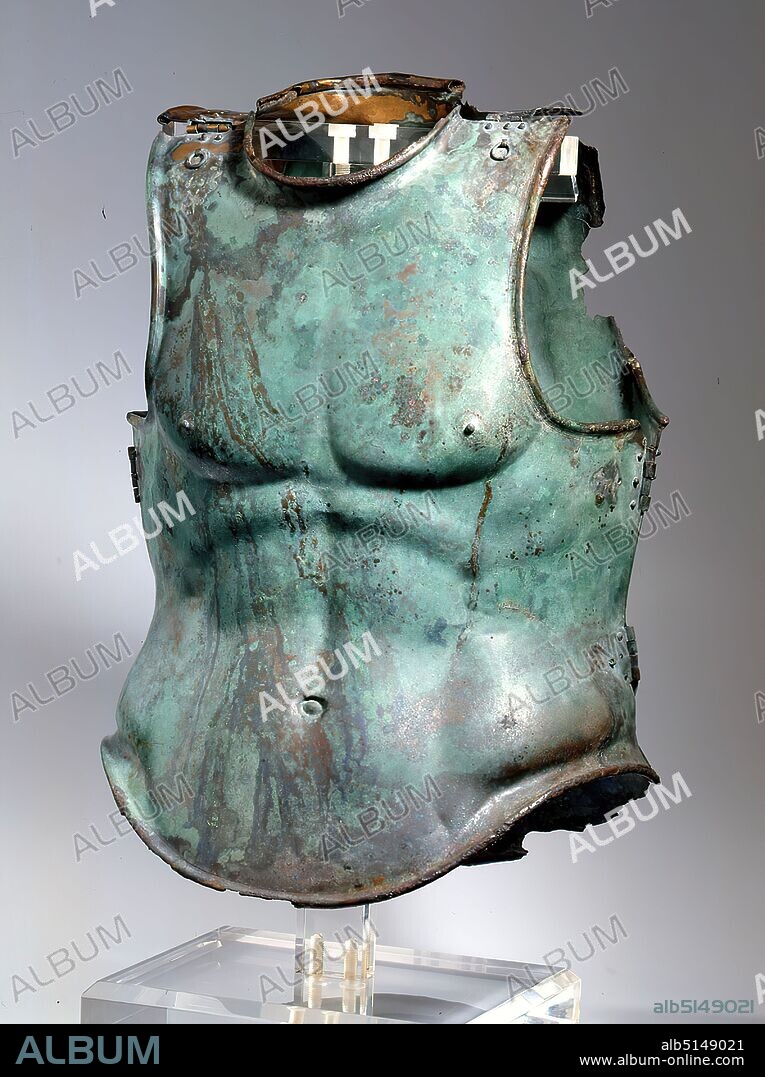alb5149021
muscle armour, bronze, cast, chased, folded, riveted, bronze, Total: Height: 54 cm; Width: 38 cm; Weight: 3.79 kg, armor (warfare/military), weapons (warfare/military), upper body (torso), chest, back, Late Classicism (Greek antiquity), The very well preserved bronze armor comes from a richly decorated warrior's grave near Grotticelle, not far from Canosa in southern Italy. Among the other finds are an iron helmet with Celtic ornaments and coral inlays, now in the Museum of Pre- and Early History in Berlin, and Apulian red figure vases by the Darius painter, now in Leipzig, New York and Boston. The armour consists of a chest and a back shell. At the sides it rests on the iliac crests and is pulled down in front like a skirt to protect the abdomen. The chest and back muscles are plastically represented, nipples and areola are made of darker metal. The edges are folded over an iron reinforcing wire. Six riveted tubular hinges hold the two halves together, two on each side and one on the shoulder. Only one of the iron pins is preserved. Each hinge has two small rings attached to the sides, each of which is fastened by rivets together with a plastically worked palmette. The rings were probably used to attach a small chain for the iron pins.

|
Ajouter à une autre Lightbox |
|
Ajouter à une autre Lightbox |



Avez-vous déjà un compte? S'identifier
Vous n'avez pas de compte ? S'inscrire
Acheter cette image

Légende:
Voir la traduction automatique
muscle armour, bronze, cast, chased, folded, riveted, bronze, Total: Height: 54 cm; Width: 38 cm; Weight: 3.79 kg, armor (warfare/military), weapons (warfare/military), upper body (torso), chest, back, Late Classicism (Greek antiquity), The very well preserved bronze armor comes from a richly decorated warrior's grave near Grotticelle, not far from Canosa in southern Italy. Among the other finds are an iron helmet with Celtic ornaments and coral inlays, now in the Museum of Pre- and Early History in Berlin, and Apulian red figure vases by the Darius painter, now in Leipzig, New York and Boston. The armour consists of a chest and a back shell. At the sides it rests on the iliac crests and is pulled down in front like a skirt to protect the abdomen. The chest and back muscles are plastically represented, nipples and areola are made of darker metal. The edges are folded over an iron reinforcing wire. Six riveted tubular hinges hold the two halves together, two on each side and one on the shoulder. Only one of the iron pins is preserved. Each hinge has two small rings attached to the sides, each of which is fastened by rivets together with a plastically worked palmette. The rings were probably used to attach a small chain for the iron pins.
Crédit:
Album / quintlox
Autorisations:
Modèle: Non - Propriété: Non
Questions sur les droits?
Questions sur les droits?
Taille de l'image:
3229 x 4320 px | 39.9 MB
Taille d'impression:
27.3 x 36.6 cm | 10.8 x 14.4 in (300 dpi)
 Pinterest
Pinterest Twitter
Twitter Facebook
Facebook Copier le lien
Copier le lien Email
Email
